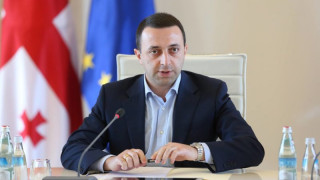Irakli Gharibashvili: “In 2020, Georgia’s economy was approximately GEL 50 billion and by January 2023, the GDP will be GEL 80 billion. In almost two years, the economy increased by nearly GEL 30 billion.”
Verdict: FactCheck concludes that Irakli Gharibashvili’s statement is FALSE.
Resume:
Irakli Gharibashvili speaks about the government’s estimates and Georgia’s GDP will reach GEL 80 billion by the end of 2023 instead of January according to GDP growth forecasts. For 2022, the estimated nominal GDP will be GEL 72.2 billion. Therefore, the nominal GDP increased by GEL 23 billion in 2022 as compared to 2020 whilst growth will be nearly GEL 30 billion if we compare 2020 with 2023 which is a three-year period.
On the other hand, using the nominal GDP to describe the dynamic of economic growth is a flawed approach because this indicator also includes inflation. This is underlined by the nominal GDP figure in 2020 which increased slightly as compared to 2019 whilst the real economy in fact dropped by 6.8% and the country experienced a severe crisis. As compared to 2020, it is expected that the real GDP growth will be 19.7% and 25.7%, by the end of 2022 and 2023, respectively, which is not a poor economic growth indicator, although it is much lower than the nominal GDP growth. Of additional note is the base effect because the economy was under tight regulations in 2020. As compared to 2019, the real economic growth is lower.
Although real economic growth figures and forecasts are generally positive, it is still wrong to analyse the economic growth dynamic by the nominal figure that the Prime Minister named. At the same time, a GEL 30 billion growth stands true in a three-year period instead of two years. In addition, the statement leaves the base effect factor unnoticed. Therefore, the statement is inaccurate and the verdict is FALSE according to FactCheck’s methodology.
Analysis
Georgian Prime Minister, Irakli Gharibashvili, speaking on estimated economic growth figures, stated: “In 2020, Georgia’s economy was approximately GEL 50 billion and by January 2023, the GDP will be GEL 80 billion. In almost two years, the economy increased by nearly GEL 30 billion.”
The gross domestic product (GDP) is the most commonly accepted indicator of the economic growth which reflects the value of goods and services produced in a country in a certain period of time. However, the GDP’s value also includes inflation because both the volume/amount and the prices of produced goods and services usually increase. This indicator is referred to as the nominal gross domestic product.
First and foremost, of note is that the Prime Minister speaks about nominal GDP statistics which was GEL 49.2 billion in 2020. However, Georgia’s GDP will only reach GEL 80 billion, as stressed by the Prime Minister, by the end of 2023 instead of January which is the beginning of the year. According to current forecasts, the nominal GDP will be GEL 72.2 billion by the end of 2022 and GEL 79.6 billion by the end of 2023. Therefore, the nominal GDP is forecast to grow by GEL 23 million in 2020-2022 whilst it will be nearly GEL 30 billion in three-years by the end of 2023.
At the same time, analysing the economic growth with the nominal GDP dynamic is wrong and the real GDP indicator should be applied in this case. In order to make sure that the GDP reflects real economic growth; that is, the real volume of the growth of goods and services, prices are adjusted to one specific year and the prices for the goods/services in that year are used for the measurement of prices of other years which excludes the effect of inflation. For instance, if 100 loaves of bread were produced in 2020 with price of one loaf at GEL 1 and 200 loaves of bread were produced in 2021 at a price of GEL 2 each, the nominal GDP increases by GEL 300 whilst the real GDP (in 2020 prices when the price of one loaf of bread was GEL 1) increases by GEL 100. In fact, the amount of produced goods and, therefore, the real GDP has doubled whilst the nominal figure shows an exaggerated size of an economy because of bloated prices.
Graph 1: Nominal and Real GDP Dynamic in 2012-2023, GEL Million

As compared to 2020, it is expected that the real GDP growth by the end of 2022 and 2023 will be 19.7% and 25.7%, respectively. Naturally, the nominal GDP growth exceeds the real GDP growth to a greater extent whilst the annual dynamic and the forecasts are generally positive. However, the base effect also needs to be taken into account. In 2020, the economy was virtually closed down due to pandemic-related restrictions which resulted in an artificial reduction of the GDP. As compared to 2019, the forecast growth of the real GDP in 2022 and 2023 will be nearly 11.6% and 19%, respectively.
Price growth has become a critical problem in the post-pandemic period which is an important factor which contributes to the so-called “bloating” of the nominal GDP. The fact that it is wrong to use the nominal GDP to describe the economic dynamic is further highlighted by the 2020 nominal GDP figure which increased slightly as compared to 2019 whereas the real economy decreased by 6.8% and the country experienced a severe crisis.








